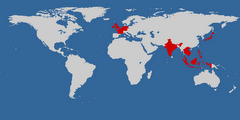Mussoorie, the third town I've visited in the northern state of Uttranchal, sits at an elevation of 2000 metres above sea level, and is a popular holiday destination for well to do Indians during the heat of the summer. It was established by the British in 1823 as a holiday retreat, and their imprint is very evident in the local architecture and public buildings. It takes an hour and a half to slowly climb the zigzagging road up here. Once you reach the top the air feels fresh, crisp, clean, and invigorating.
Mussoorie is an affluent place, and there's very little evidence of poverty. The town's 300 hotels do good business, and tourism seems to provide well enough for the 29 000 residents who live up here. Judging by the steepness of the lanes and pathways I assume that brake pad salesmen are amongst the wealthiest individuals in this hill top society.
The views are sublime. The brown, wrinkled Himalayan hills stretch all around (in winter they're snow capped) and make for mesmerising viewing. Closer by the lower hills are covered in healthy dark green pine trees and other vegetation.
I've been here for two days now, staying at the Hotel Broadway, an elegant green and white house with a glass windowed gallery on the first floor. It was built back in the 1880s, and my room (decorated around the same time I think - but still very charming) looks out across the hills. An uninterrupted view. Hotel Broadway is tucked away in a quiet corner of the town, and has proved a very relaxing place to stay.
Most of the time I've been out walking, either up and down through the pedestrian streets of the town, or along the roads which stretch out into the surrounding hills where I can seek out magnificent views and vistas. Yesterday I walked up Gun Hill to the highest point in Mussoorie (2500 metres). I had a cup of tea at the top and tried to disguise my irritation when I realised there was a cable car I could have come up in rather than slowly puffing and wheezing my way up the steep footpath. And later, whilst wandering, I stumbled on the homes of the Tibetan community here.
On the food front: I've tried rasmalai (dumplings made from cottage or riccotta cheese soaked in sweetened, thickened milk delicately flavored with cardamom and served chilled), and also some more varied types of parantha (bread) for my breakfast. Mussoorie can cater for all tastes: there are Punjabi restaurants, South Indian restaurants, Bengali sweet shops, Tibetan cafes, and a Dominos Pizza parlour. There are also a couple of bars up here where you can buy cool bottles of Kingfisher Beer. I've taken advantage of this.
But all good things must come to an end, and with a heavy heart I will move on tomorrow morning to my next destination: Shimla. It's going to take at least 12 hours to get across to what was the summer capital of the British Raj, and I'm quietly not confident the journey will be smooth, but the effort will be worth it I'm sure.
